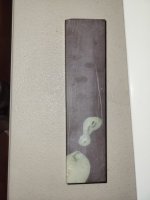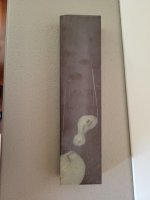As far as the temper, discoloration is the first clue. However if they did grind then buff it, the buffing can take the discoloring off. Beyond that, you need some sort of hardness tester. I have a set of hardness files that will let you know within a 5 hrc range. If you do end up sending it off this way, we can make sure it's still between 60 and 65 at least.
Technically, you can go from a broken piece of concrete to a hard ark. It just depends on how much work you want to put into it. Also, intended use plays into how fine of an edge you want. You hone a low angle and 12k finish it will slice like no tomorrow, but you take it out and chop a piece of kindling wood for your campfire and you will destroy it. Same in reverse, You put a nice 6 or 8 hundred grit apple-seed edge on and it will chop all day, but it will never give you a paper thin slice of anything. So there is a use for the lower grit stones, it just depends on how much time (and money) you want to spend on each stone and what you want your end result to be.
For a basic setup, a 220 or 400ish to 1k will work just fine. Realistically with proper maintenance on a good edge, you won't ever need to go to the 220 unless you do something that chips the edge and you need to do some serious hogging to get it out.
For your setup, I would say the 3k would fit in nicely. I have the 2k for setting bevels on straight razors. (then a 5 and 8 before getting to my naturals) They are very fast cutters, so I can do the work that normally needs a 1k but leave a smaller scratch pattern to remove. I just flip it to the back side if I need to touch up a kitchen knife.
The 3k for you would still be aggressive enough that you shouldn't need to put in a crazy amount of time to get the 1k scratches out, but be fine enough to make the jump to 6k more pleasant also.


